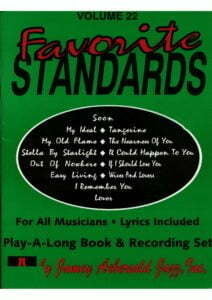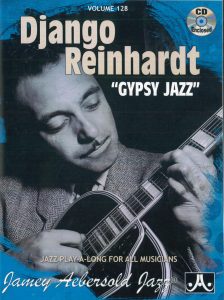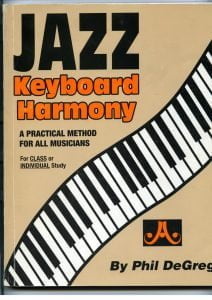Play Jazz Standards Travelin’ Blues – Dave Brubeck – Jazz play Along Free sheet music in our online library.
provider: dailymotion
url: https://dai.ly/k5vEKcD3MyZ0iaxLz1m
src: https://geo.dailymotion.com/player.html?video=x892c8o&
src mod: https://geo.dailymotion.com/player.html?video=x892c8o
src gen: https://geo.dailymotion.com/player.html?video=k5vEKcD3MyZ0iaxLz1m
Jamey Aebersold has gone to great lengths to put together fine rhythm sections and fairly accurate chord progressions into a neat little bundle, to make it easier for you to learn any jazz standard in the comfort of your own home, even without a band! The sheet music is also accurate and completed with the right chords.
Using jazz standard play alongs and lead sheet music as tools
Play alongs do have some benefits:
- The soloists are out of the way so you can focus more easily on the rhythm section
- The changes are more defined and easier to hear
- The track stays consistent in terms of harmony
These attributes make jazz standard play alongs great for practicing exercises with. To use a play along effectively to improve at a tune, abandon the attitude that it exists simply for for your desire to “just play” while having a band back you up, and instead create exercises which will help to do the following:
- Integrate new bits of language into your vocabulary
- Isolate a concept
- Work on problem chords
- Work on figuring out chords by ear
- Any other creative things you can come up with
When you use play alongs during your practice, make sure you’re implementing some type of exercise and do not get carried away by the urge to “just play.”
Utilizing play alongs in this manner will help you improve much more rapidly than if you put a tune from a play along on repeat and improvise over it endlessly.
We all have those chords that we get to and just freeze. That’s a problem chord. Most of time, rather than work on these chords, we glide over them, or use one approach we’ve figured out that kind of works, but not perfectly.
Slow it down. Then figure out ways your heroes dealt with a similar situation and use that knowledge to experiment with how you’ll approach the problem chord. Loop the section in the jazz play along and apply your new knowledge until you gain a firm understanding of how to go about playing over that particular harmonic instance.
After you feel you’ve sufficiently worked on things, then give yourself the opportunity to work on performing. Feel free to Let loose and enjoy just playing for a bit.
Remember to practice in the practice room and perform when you’re on the bandstand!



Dave Brubeck
In the 1950s and ’60s, few American jazz artists were as influential, and fewer still were as popular, as Dave Brubeck. At a time when the cooler sounds of West Coast jazz began to dominate the public face of the music, Brubeck proved there was an audience for the style far beyond the confines of the in-crowd, and with his emphasis on unusual time signatures and adventurous tonalities, Brubeck showed that ambitious and challenging music could still be accessible.
And as rock & roll began to dominate the landscape of popular music at the dawn of the ’60s, Brubeck enjoyed some of his greatest commercial and critical success, expanding the audience for jazz and making it hip with young adults and college students.
David Warren Brubeck was born in Concord, California on December 6, 1920. Brubeck grew up surrounded by music — his mother was a classically trained pianist and his two older brothers would become professional musicians — and he began receiving piano lessons when he was four years old. Brubeck showed an initial reluctance to learn to read music, but his natural facility for the keyboard and his ability to pick up melodies by ear allowed him to keep this a secret for several years. His father worked as a cattle rancher, and in 1932, his family moved from Concord to a 45,000-acre spread near the foothills of the Sierras.
As a teenager, Brubeck was passionate about music and performed with a local dance band in his spare time, but he planned to follow a more practical career path and study veterinary medicine. However, after enrolling in the College of the Pacific in Stockton, California, Brubeck played piano in local night spots to help pay his way, and his enthusiasm for performing was such that one of his professors suggested he would be better off studying music. Brubeck followed this advice and graduated in 1942, though several of his instructors were shocked to learn that he still couldn’t read music.
Brubeck left college as World War II was in full swing, and he was soon drafted into the Army; he served under Gen. George S. Patton, and would have fought in the Battle of the Bulge had he not been asked to play piano in a Red Cross show for the troops. Brubeck was requested to put together a jazz band with his fellow soldiers, and he formed a combo called “the Wolfpack,” a multi-racial ensemble at a time when the military was still largely segregated.
Dave Brubeck was honorably discharged in 1946, and enrolled at Mills College in Oakland, California, where he studied under the French composer Darius Milhaud. Unlike many composers in art music, Milhaud had a keen appreciation for jazz, and Brubeck began incorporating many of Milhaud’s ideas about unusual time signatures and polytonality into his jazz pieces.
In 1947, Brubeck formed a band with several other Mills College students, the Dave Brubeck Octet. However, the Octet’s music was a bit too adventurous for the average jazz fan at the time, and Brubeck moved on to a more streamlined trio with Cal Tjader on vibes and percussion and Ron Crotty on bass. Brubeck made his first commercial recordings with this trio for California’s Fantasy Records, and while he developed a following in the San Francisco Bay Area, a back injury Brubeck received during a swimming accident prevented him from performing for several months and led him to restructure his group.
Brubeck Time
In 1951, the Dave Brubeck Quartet made their debut, with the pianist joined by Paul Desmond on alto sax; Desmond’s easygoing but adventurous approach was an ideal match for Brubeck. While the Quartet’s rhythm section would shift repeatedly over the next several years, in 1956 Joe Morello became their permanent drummer, and in 1958, Eugene Wright took over as bassist. By this time, Brubeck’s fame had spread far beyond Northern California; Brubeck’s recordings for Fantasy had racked up strong reviews and impressive sales, and along with regular performances at jazz clubs, the Quartet began playing frequent concerts at college campuses across the country, exposing their music to a new and enthusiastic audience that embraced their innovative approach.
Dave Brubeck and the Quartet had become popular enough to be the subject of a November 8, 1954, cover story in Time Magazine, only the second time that accolade had been bestowed on a jazz musician (Louis Armstrong made the cover in 1949). In 1955, Brubeck signed with Columbia Records, then America’s most prestigious record company, and his first album for the label, Brubeck Time, appeared several months later.
Time Out
A steady stream of live and studio recordings followed as the Dave Brubeck Quartet became the most successful jazz act in the United States, and in 1959, they released one of their most ambitious albums yet, Time Out, a collection of numbers written in unconventional time signatures, such as 5/4 and 9/8. While Columbia were initially reluctant to release an album they felt was too arty for the mainstream, their fears proved groundless — Time Out became the first jazz album to sell a million copies, and in 1961, it bounded back into the charts when “Take Five” unexpectedly took off as a single, rising to 25 on the pop charts and five on the adult contemporary survey.
As Brubeck enjoyed increasing commercial success, he began exploring new musical avenues; in 1959, the Brubeck Quartet performed with the New York Philharmonic, performing “Dialogues for Jazz Combo and Orchestra,” a piece written by Howard Brubeck, Dave’s brother. Dave’s own composition “Elementals,” written for orchestra and jazz ensemble, debuted in 1962; “Elementals” was later adapted into a dance piece by choreographer Lar Lubovitch.
And Brubeck and his wife, Iola, wrote a song cycle called “The Real Ambassadors” that celebrated the history of jazz while decrying racism; it was performed at the 1962 Monterey Jazz Festival, with contributions from Louis Armstrong, Carmen McRae, and Lambert, Hendricks & Ross. The Brubeck Quartet also became international stars, with the State Department arranging for them to perform in locales rarely visited by jazz artists, including Poland, Turkey, India, Afghanistan, Iraq, and Sri Lanka.
Two Generations of Brubeck
In 1967, Brubeck dissolved the Dave Brubeck Quartet and began devoting more time to composing longer works that often focused on his spiritual beliefs, including an oratorio for jazz ensemble and orchestra, “The Light in the Wilderness,” which debuted in 1968; “The Gates of Justice,” first performed in 1969, which melded passages from the Bible with the writings of Martin Luther King, and “Upon This Rock,” which was written for Pope John Paul II’s visit to San Francisco in 1987.
Dave Brubeck continued to perform in a more traditional jazz format as well, forming a new combo in 1968 featuring Jack Six on bass, Alan Dawson on drums, and Gerry Mulligan on baritone sax. In the ’70s, Brubeck also toured with a group featuring his sons Darius (keyboards), Chris (bass and trombone), and Dan (drums); dubbed Two Generations of Brubeck, the ensemble performed a bracing fusion of jazz, rock, and blues. In 1976, Brubeck reassembled the classic lineup of the Dave Brubeck Quartet for a 25th anniversary tour; the reunion was cut short by the death of Paul Desmond in 1977.
From the mid-’80s onward, Brubeck maintained a schedule that would befit a rising star eager to make a name for himself rather than a respected elder statesman. He continued to compose orchestral works as well as fresh jazz pieces, and recorded and performed on a regular basis with a variety of accompanists. Perhaps the most honored jazz artist of his generation, Brubeck received awards from two sitting United States Presidents — Bill Clinton presented him with the National Medal of the Arts in 1994, and Barack Obama presented him with the Kennedy Center Honors in 2009.
Brubeck also received a star on the Hollywood Walk of Fame, a lifetime achievement Grammy from the National Academy of Recording Arts and Sciences, the Smithsonian Medal, and honorary degrees from universities in five different countries, among many other awards for his life in music. When he died of heart failure late in 2012, just one day before his 92nd birthday, his life and his work were celebrated around the world.
